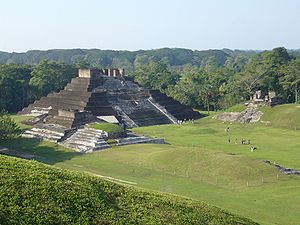 | ||
| Comalcalco | ||
| State | Tabasco | |
|---|---|---|
| Residents | unknown | |
| no value for residents on Wikidata: | ||
| height | unknown | |
| no value for height on Wikidata: | ||
| no tourist info on Wikidata: | ||
| location | ||
| ||
Comalcalco is a Mayan ruin in Tabasco in Mexico.

background
Comalcalco is the most northwestern Mayan ruins and named after the city of the same name. Even if little is known about this ruins, it can boast beautiful pyramids in an architectural style that is unique in the Mayan world. Most of the buildings date back to the 8th century AD. A burial chamber found here contained writings from AD 771. But the origin of the city is to be set much earlier. So there is in the with Palenque befriended Mayan city Tortugero an inscription that indicates a crushing defeat of Comalcalco against Tortugero on December 23rd, 649 AD. The inscription even speaks of a bloodbath and mountains of corpses. The heyday of this city was around 900 AD, but it was probably abandoned a few years later for unknown reasons. In 1820 the city was rediscovered. In 2011 it became known that a brick built in a pyramid had been found during the excavations, the date of which is identical to the end date of the large census on December 21, 2012 and reports of an arrival. The general excitement in the press and among doomsday speculators about it could not be shared by archaeologists, as this could just as well be a bygone date, e.g. from the late classical period.
getting there
By plane
By train
In the street
Of Villahermosa you drive the MEX 180 up to Cardenas. After about 50 km and in the middle of Cárdenas (Av. San Juan), turn right towards Comalcalco. After another 40 km you will reach Comalcalco. You cross this almost completely in a northerly direction. At the Carretera a La Zona Arqueológica, turn right and after about 400 meters you will reach the ruins.
There are regular bus connections with Villahermosa. The agencies Comali Plus (Calle Reforma at Calle Bravo) and Transportes Torruco (Calle Reforma at La Arboleda) are located near the ADO bus station (see How to get there). These offer a transfer service for US $ 2.50 every 20 minutes from 4:30 in the morning until 9:00 in the evening. The journey takes about 45 minutes.
By boat
mobility
The buses all go to the city center. The terminals are not directly at the Zocalo, but this can be reached on foot. However, the ruin is a bit outside. For this you should use a taxi that can easily be hailed on the street. For the way back, a taxi can be called by the staff at the entrance area.
Tourist Attractions

The pyramids are unique, and the way they are built guarantees that. Since the city was far away from the nearest quarries, they worked here with fired bricks made of clay, sand and shell shells.
So far, 300 structures have been discovered on the 7 km² facility. So far, two areas have been excavated and viewed:
- Gran Acropolis. This is where the "Plaza de la gran Acropolis" connects with a few other smaller pyramids.
- Temple I.. This is where the "Plaza Norte" joins with further pyramids.
The pyramids are up to 35 meters high and are partially decorated with beautiful frescoes and masks.
The museum provides information and shows finds from the facility.
Opening times 10:00 a.m. to 5:00 p.m. (closed on Mondays)

